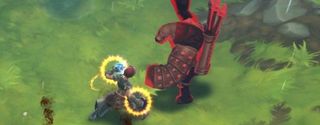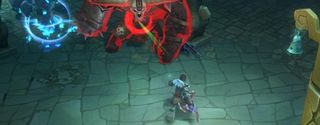Torchlight 2 first impressions: breaking ground in Runic's action RPG

When I play RPGs, I create one character and I stick with them. I share an office with people who do things differently: whose first dozen hours with a new game are spent cycling through possibilities, repeating opening areas until something clicks or the game dies of inertia. I commit to my characters because what I enjoy about RPGs is advancement, exploration, and momentum. I'd rather make a decision quickly and see where it takes me than agonise over the choice on offer, which is both why I'm capable of buying trousers very quickly and also why I should never do jury duty.
I've just finished playing the opening two hours of Torchlight 2 for the fourth time in a row. I've levelled each of the game's classes to the point where I feel I know what their deal is. I've killed the same three bosses in a variety of positions, swapped loot around using the shared stash and created a new set of angles from which to take on the rest of the game. I've put off commitment by around eight hours.
I've done this because, frankly, my first impressions of the game weren't great. I came very close to bouncing off Torchlight 2, and I wouldn't be surprised if players picking up the game tonight experience something similar. My full review will come on Monday, but I wanted to put together some initial impressions to explain how I cracked Torchlight 2's outer layer.
An animated intro sets the stage - the first game's Alchemist character has gone bananas, putting the torch to Torchlight and storming off into the wider world. You're promptly plonked into the middle of a rainswept fen, given a path to storm down and an array of rat-men to batter.
So that's one wrecked village, one renegade former protagonist, and one blasted heath to chase them over. Torchlight 2's setup echoes Diablo 2 in the same way that the original game echoed Diablo 1. It's an odd decision, creatively: it works as an homage, but means that the game has to do that much more to set itself apart from its phenomenal forebear and - by extension - Diablo 3. I'd also like to have a heart to heart with whoever decided that all action RPGs need to begin in a shitty field in the middle of nowhere.

I started with the Outlander, a hybrid mage and ranged DPS class that on the surface closely resembles the Vanquisher I played in the original game.
Popping shots at my first few rat-men, something immediately felt slightly off. There's a delay between clicking and attacking determined by the speed of your weapon, something that Torchlight 2 shares with other action-RPGs but that grinds against expectation in the world post Diablo 3. Runic's system is mechanically sound but just doesn't have the punch and splatter that Blizzard spent a decade perfecting. There's a night-and-day difference between the relative resources of the two games, and a comparison of the two has to go far deeper than what it feels like to turn a monster into high-velocity meat: but if you spent your summer in Blizzard's company, you'll need to get comfortable with something slower before Torchlight 2 opens up to you.
PC Gamer Newsletter
Sign up to get the best content of the week, and great gaming deals, as picked by the editors.
The same applies to levelling up. Each new level grants you a set of attribute points to invest in one of four stats and a single skill point to spend. As in the original Torchlight, improving stats allows you to equip gear above your level, which means you're often guided more by the next weapon you want to use than the actual benefits of increasing an attribute.
Stats offer something to every class. The caster-centric Focus attribute, for example, also buffs the chance that a dual-wielding character will strike with both weapons at once. It's nonetheless the case that each point you invest increments your power by a tiny amount: when you're not working towards a particular item, the temptation is just to dump them into whatever looks good at the time. There's certainly depth here but the chief satisfaction of levelling up is stretched out over a character's lifetime, rather than getting a cool new toy with every ding.
The skill system, meanwhile, provides you with active and passive abilities split across three categories. Every class can use every weapon, but many skills are restricted to particular weapon types: so your choice of category has a big influence on what you'll end up wielding. New skills become available across all three categories as you level, so you're free to dabble as you gain in power. Most of your skill points, however, will be spent on ranking up the abilities you already have. As with attribute points, the imperceptible impact this has on your overall power makes each individual point unsatisfying to spend in the short term.
You're also very limited in your capacity to respec. You can undo the last three skill decisions you made, but no further: while I appreciate the old school rigour, it feels like an odd, restrictive decision. It's great that the game supports mods, and that - like the original Torchlight - players will undoubtedly introduce full respecs and extended level caps: but I'm not sure what fretting over a point investment adds to the game as it currently stands, especially when each point seems to do so little.

So: I killed some monsters, I levelled up, and I was underwhelmed by both. I pressed on, through ups and downs. I liked the scale of the game's bigger fights, where hordes of monsters offer themselves up for the slaughter, masking Torchlight 2's weaker-feeling combat through sheer strength of numbers. I disliked the time I spent trying to make use of a massive cannon I'd found, its slow attack speed, limited range and lack of a visible projectile making it feel like I was operating one of those bucket-sized bubble guns. I beat the first major boss, returned to the hub town, and realised that I needed to reroll. All of my problems with the game were stemming from microscale dissatisfactions: the kind of thing that could well be down to class choice.
As I see it, action RPGs are operate from second to second, minute to minute, and hour to hour: or, alternatively, click to click, fight to fight, and area to area. Torchlight 2 loses the battle on the short end of that scale to Diablo 3's razorwire immediacy, but really starts to shine in the middle and, potentially, the long run. Even in these early levels, T2 is a more diverse game than Diablo 3: it takes randomisation substantially further, remixing the overworld as well as dungeons and littering both with random events that continually pull you away from the main track. If you enjoyed the thinking behind Diablo 3's gold-spouting treasure goblins, you'll find a lot to like here: from phase beasts leave behind portals to challenge stages, to secret sidequests and locked chests that encourage you to push the fog of war all the way back every time you generate a new map.
Loot, too, is more exciting: unique items and set bonuses appear from level one, giving you a glimpse of the system's depth that draws you in further. I've already seen swords that can level up, axes that summon meteor strikes, and armour that changes the way characters build their power-boosting charge bar. Torchlight 2's itemisation does from the get-go what Diablo 3 saves for the endgame, and that's a major mark in its favour.

I've enjoyed the game more and more on this level as I've created new characters. The Outlander is cagey to play: fragile and position-dependent in a way that, I now realise, exacerbates my issues with the game's feel. The Berserker is much better, able to dash through mobs of foes ripping critical hits out of everything in her path. The Engineer's ability to boost two-handed weapon speed encouraged me to give cannons another shot. As I suspected, I had picked the wrong class for me: but it's an easy mistake to make. You don't necessarily see the word 'engineer' and think 'heavy melee weapon wielding tank'.
I've settled on the Embermage for the long haul: in my case, a wand wielding lightning rod who compensates for that second-to-second sluggishness with a bullet hell's worth of screen-filling laser death. I've gone for perks that emphasise spectacle: attacks from my wands now have a chance to summon an additional random effect, from freezing explosions to fireballs. My go-to skill is a rapid-fire burst of homing magic missiles, with short-range lightning for support and a hilarious passive that randomly teleports melee attackers safely out of reach. This is where the game starts to click: it's just a shame that it took me eight hours to get there.
Tomorrow we'll be posting guides to Torchlight 2's classes: if you're playing tonight, I recommend dabbling before you commit. The mid-level stuff that the game does so well - the heavy randomisation, the variety of encounters and loot - makes repeated play of the same areas far more bearable than it would otherwise be, and I can attest to the value of experimenting until you find a character that suits you. Now, if you'll excuse me: I've got skeletons to turn into ash. Check back for our full review on Monday.
Joining in 2011, Chris made his start with PC Gamer turning beautiful trees into magazines, first as a writer and later as deputy editor. Once PCG's reluctant MMO champion , his discovery of Dota 2 in 2012 led him to much darker, stranger places. In 2015, Chris became the editor of PC Gamer Pro, overseeing our online coverage of competitive gaming and esports. He left in 2017, and can be now found making games and recording the Crate & Crowbar podcast.
Most Popular


